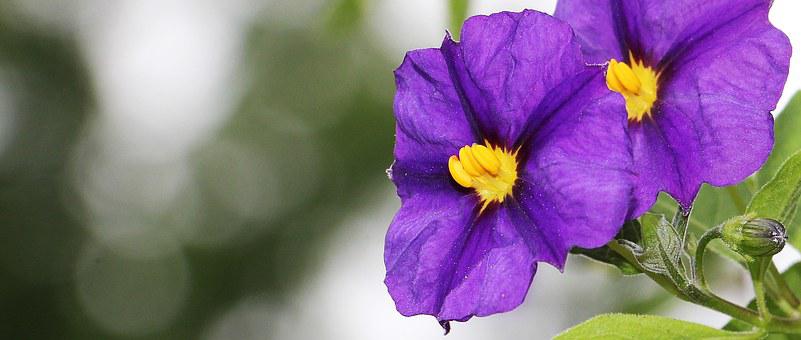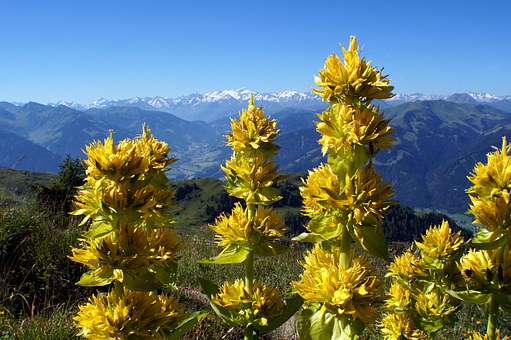
Last updated on May 20th, 2023 at 11:19 pm
The Gentians (official name: Gentiana), belonging to the Gentianaceae family, hail from the Northern Hemisphere’s temperate mountain regions and the Andes. The plant is most common in Asia, Europe, and North and South America, where the climate is more volatile.
The plant is named after King Gentius of Illyria (modern-day Albania), who discovered the plant’s healing properties. The Gentians comprise a large genus with over 1,000 species identified in various geographical locations ranging from bogs to deserts.
With trumpets shaped flowers and narrow green foliage, the Gentians mesmerize us with their deep blue blossoms. However, a plant’s shape, size, and color differ based on where it is grown. Gentians are resilient plants that prefer to grow in humus-rich, well-draining, gritty soils in full sun or moderate shade. An interesting feature of the plant is it wilts if given quality soil and nutrients.
It’s a tough plant that grows 10-30 cm tall and is common in rock gardens. These plants are at their finest between July and October. Letting the plant alone is critical to maintaining its healthy and profuse flowering. It’s enough to fertilize these magnificent plants once a year in the spring to keep them going for years.
What does the Gentian flower symbolize?
The gentian is among the three European Alps’ emblematic flowers. The Minamoto clan, one of the four major clans that controlled Japanese politics during the Heian period, had the gentian blossom as their emblem.
The gentian flower meaning represents passion, allure, loveliness, and sweetness. It is seen on a variety of souvenirs and works of art.
Due to its upright blossoming shape, the gentian flower’s meaning and symbolism are frequently referred to as the “flower of victory” alongside gladiolus.
In addition to white lilies and red roses, gentians are frequently seen being laid in the foreign cemetery in Yokohama. The red rose and lily depict love and solemnity, while the flower meaning of gentian is “to have sympathy for your pain.”
Japanese people have adored the plant since the Fujiwara period (898- 1185), and then on, the plant is especially popular in Japan. The gentian is the prefectural flower of Japan’s Kumamoto and Nagano cities.
Since 1926, the fringed gentian has been the official flower of Yellowstone National Park in the United States.
Gentians have also found their place in poems and novels, which boasts about their deep hue. A statue of D.H Lawrence holding a blue gentian flower is situated at the University of Nottingham, England, owing to the author’s fondness for the flower.
Gentian roots had a significant part in mythology. It was widely employed in place of mandrake, which was highly expensive at the time, for countless incantations and ceremonies during the Middle Ages.
All in all, the gentian flower symbolic meanings are:
- justice
- victory
- sweet
- generous nature
- passion for life
- charm
- attraction
Meaning of the Gentian flower colors
Yellow color
The yellow gentian flower represents power and strength. These flowers are known as appetite powder in veterinary medicine. Their medical and ornamental properties make them extremely useful.

Pink color
Rose gentians, or Sabatia angularis, gets its name inspired by an Italian botanist, Liberato Sabbati. The pink color of the flower represents grace, femininity, tenderness, and happiness.

White color
White flowers can convey reverence, modesty, freshness, and simplicity. The color can be either strong and spectacular or soft and self-effacing.

Interesting facts about the Gentian flowers
- Those who lived in the mountains used gentians to predict whether winter would be severe; the longer the gentian flowered, the harsher the winter would be.
- Gentian has been an ingredient in liqueurs, bitters, and herbal medication for decades.
- For generations, painters have waxed poetry about it. Emily Dickinson and DH Lawrence greatly liked the flower and wrote lovely poetry about it.
- Gentians pollinate unusually. The buds of some gentian flowers will open once the suitable pollinator pushes them to reveal their inner pistils and stamens, a fascinating feature of gentian flowers.
- Gentian roots were kept in shoes by mountain farmers in the Alpine regions to help with weak, sweating feet.
- Periwinkle, Milkweed, Madder, Coffee, and Dogbanes are close members of the gentian family.
- Propagating gentian flowers away from their natural habitat can be extremely difficult.
- They die above the soil surface and hibernate beneath the earth if disturbed.
- Very rarely, gentians are used in soaps and perfumes.
How to grow Gentian flowers
Regular care is necessary for the gentian flower to grow and flourish. You’ll find the extra effort is worthwhile when your gentian wildflowers bloom in your landscape.
- Plant the gentians in humus, moist soil.
- Place them in a spit with full sunlight or partial shade.
- Keep soil moist by regular watering but do not drench.
- Divide the plants at the start of spring in cool areas or following flowering in warmer areas.
How to care for Gentian flowers
- Water the gentians when the soil’s surface has dried out.
- Never disturb the roots or move the plants during the growing season.
- Feed the plants growing in the flowerbed with a slow-release fertilizer.
- Prune in spring before the new sprouts appear.
Best time to gift Gentian flowers
Gentian flowers make up great gifts to commemorate triumph since they represent victory. Gentians and roses were used in the Tokyo Paralympics to honor the glorious moments of participants during the game.
The gentians, together with Eustomas, bordered the roses in these triumph bouquets, the Gentian flower meaning all those who support and cheer for athletes from all across the world.
Conclusion
The gentian has the widest range of true blue than any flower. Being a late bloomer flower, gentian adds beauty to your garden far into the fall. Being a lovely perennial reflecting its natural home in Alpine meadows, it draws attention because it’s as beautiful as a picture.
Gentian represents a wide range of beneficial properties. These deep symbols and meanings give the flower its uniqueness and identity.
If you want to know and learn more about flowers, we at PansyMaiden can help you. Check out our fun, easy-to-read, and informative flower-related content that you will surely enjoy!
